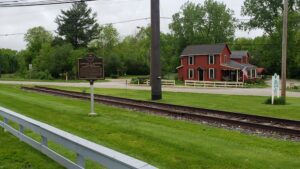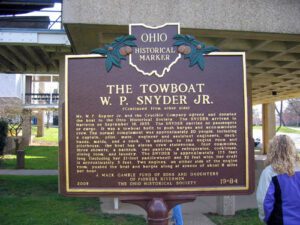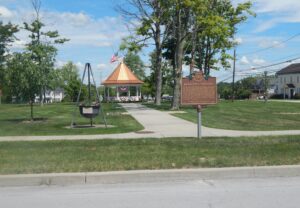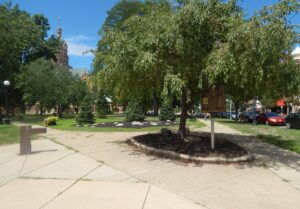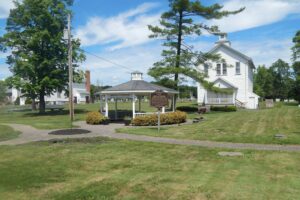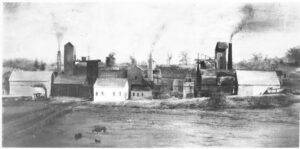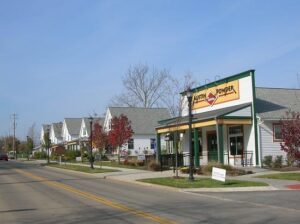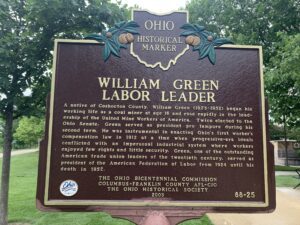, OH
The Randall Secondary rail line dates to the 1850s when the independent Cleveland & Mahoning Railroad (C&M) laid tracks through Aurora, Ohio. C&M, chartered in 1848, linked the Mahoning Valley coal and iron ore fields to the industries and lake port at Cleveland. For over a century, the Randall Secondary contributed to Aurora’s economic life ? fueling the region’s rapid growth during the late 19th and early 20th centuries. In its heyday, the line was an important route for commuter transport and freight service along the 67 miles between Cleveland and Youngstown. Although passenger service into Aurora Train Station stopped in the 1960s, freight service continued into the 1990s. The last remaining track of the Randall Secondary in Aurora stands near the station it served.
, OH
The W.P. SNYDER Jr. is one of the few links between the age of steam-powered, stern-wheeled towboats and the diesel-powered, propeller-driven vessels that push barges on America’s rivers today. The James Rees and Sons Company in Pittsburgh built the boat for the Carnegie Steel Company, and she was launched in 1918 as the W.H. CLINGERMAN. During the boat’s working life, she primarily pushed barges loaded with coal on the Monongahela and Ohio Rivers. After various changes in name, the Crucible Steel Company of America bought the boat in 1945 and named her the W.P. SNYDER Jr. after the company’s president. Crucible retired the SNYDER in 1954 and, as was the fate of her kind, she would have probably been scrapped. In 1955, however, the Sons and Daughters of Pioneer Rivermen and the Ohio Historical Society concluded that one example of a steam towboat should be preserved. (continued on the other side)
, OH
In 1798, Judge Samuel Hinckley of Northampton, Massachusetts, drew the 72nd draft in the land lottery held by the Connecticut Land Company and received 15,305 acres in Township 4, Range 1, for which he paid $12,903.23, less than one dollar per acre. The area had been inhabited for many years by trappers, missionaries, and Native Americans. One of the earliest settlers was James McMullen, who acquired the first 160-acre parcel from Hinckley in 1801. Brookfield Township became the crown jewel of Hinckley’s holdings. Hinckley named Brookfield after a city in England and set aside land for the village green and the cemetery stating that they were for public use forever. During the mid-1820s the Overland Stage Line had a run through Brookfield, linking it to Salem, Warren, and Youngstown in Ohio and Erie, Pennsylvania and Dunkirk, New York. (Continued on other side)
, OH
The decision to build the P&O Canal resulted from several canal conventions at Warren’s first courthouse in 1833. Canal advocates from Warren included Simon Perkins, Leicester King, David Tod, and Calvin Pease. Finished in 1840, this 82 mile canal linked two north-south canals, the Beaver Canal and the Ohio and Erie Canal, via an east-west route for passengers and commerce. By 1856, the Pennsylvania & Ohio Canal was replaced by the railroad and the entire route was abandoned by 1872. (Continued on other side)
, OH
The Connecticut Land Company surveyed Vienna Township as Township 4, Range 2, in 1798. The Township’s proprietors were Ephraim Root, Uriel Holmes, Jr., and Timothy Burr. Survey members Dennis Clark Palmer, Isaac Flower, and Samuel Hutchins and their families were the first to settle here in 1799. Between 1810 and 1840, Vienna was a center for the wooden works clock industry in Trumbull County and the Connecticut Western Reserve, with six factories located amid farms, sawmills, and quarries. After coal was discovered in 1866, over twenty mines were opened, bringing boom times for two decades. Vienna’s miners helped to bring about Ohio’s first mining safety law in 1874. Vienna was the birthplace of abolitionist and attorney John Hutchins (1812-1891), who represented Trumbull and Ashtabula counties in the United States Congress (1859-1863) and raised troops during the Civil War.
, OH
The discovery in the mid-19th century of iron-rich black band ore in this region helped revitalize Mahoning Valley’s iron industry. The land now called Mineral Ridge was primarily a farming community before the 1850s. In the 1830s, coal was discovered and mining began on a small scale. For years, it was believed that the coal seam sat on top of a layer of slate, which was considered to be of little worth. In the mid-1850s, however, John Lewis, superintendent of the Mineral Ridge Coal Mines, identified what was previously thought to be slate as valuable black band ore instead. (Continued on other side)
, OH
The Village of Glenwillow was developed and has survived over the last century as a rural enclave whose character has been shaped by the Austin Powder Company. Glenwillow began as a company town of the Austin Powder Company, which relocated its explosives factory from Cleveland in 1892. The Falls Junction Depot was originally built in 1883 and located approximately 1/4 mile to the north at the junction of the existing Wheeling and Lake Erie track and a rail line that connected to Chagrin Falls. The Depot was moved to its present location when Austin Powder Company relocated to Glenwillow. Passenger trains on the Wheeling and Lake Erie Railway provided Glenwillow residents access to the larger cities of Cleveland, Kent, and Akron, and provided a route for Austin Powder to ship its explosives to mines in southeast Ohio. The Depot, which operated until 1974, is now an important component to the revitalization of the Glenwillow Town Center.
, OH
A native of Coshocton County, William Green (1870-1932) began his working life as a coal miner at age 16 and rose rapidly in the leadership of the United Mine Workers of America. Twice elected to the Ohio Senate, Green served as president pro tempore during his second term. He was instrumental in enacting Ohio’s first worker’s compensation law in 1912, at a time when progressive-era ideals conflicted with an impersonal industrial system where workers enjoyed few rights and little security. Green, one of the outstanding American trade union leaders of the twentieth century, served as president of the American Federation of Labor from 1924 until his death in 1952.


